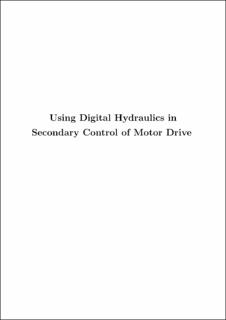| dc.description.abstract | Due to the increased focus on pollution and global warming, there is a demand for energy efficient systems. This also applies to the offshore oil and gas industry. Normally used hydraulic systems tend to suffer from low energy efficiency, especially when operating with part loads. In the last decades, a new pump and motor technology has experienced increased interest due to the potential of high energy efficiency in a wide range of operation conditions. This new technology is called digital displacement machine technology. Nowadays, there is a desire from the offshore oil and gas industry to use this digital displacement machine technology to design highly efficient hydraulic winch drive systems.
The main objectives of the work presented in this thesis are to design a controller for a digital displacement winch drive system and evaluate its control performance. The design of a controller is one part of the work needed to realizing a winch drive system with digital displacement machines. A winch with a lifting capacity of 20000 kg and a drum capacity of 3600 m of wire rope is used as a case study.
Digital displacement machines have strict requirements for the on/off valves used to control each cylinder chamber. It is important to activate the valves at optimal times to ensure operation with high energy efficiency and low pressure and flow peaks. Only a small mistiming of the valves will affect the performance of the digital displacement machine significantly. One of the first contributions presented in this thesis is a method for defining how early or late the valves can be timed without reducing the energy efficiency significantly.
The control of digital displacement machines is complicated and non-conventional. Each cylinder can be controlled individually and multiple displacement strategies can be used to achieve the same displacement. Each displacement strategy has its dynamic response characteristics and energy efficiency characteristics. The dynamic response characteristics of the drive system are highly relevant when designing control systems. Therefore, in addition to the conventional classical controller, also a suitable displacement strategy must be designed. Designing controllers for digital displacement machines are therefore more complex than designing controllers for conventional hydraulic machines.
One of the main focuses of this project has been to analyze the transient and steady state response characteristics of different displacement strategies. In all, three displacement strategies are examined: full stroke displacement strategy, partial stroke displacement strategy and sequential partial stroke displacement strategy. Also, during this work, a new version of the partial stroke displacement strategy has been developed and included in the dynamic response analysis.
The dynamic response analysis is a simulation study, where the simulation model is experimentally validated. The experimental work is conducted on a prototype of a single cylinder digital displacement machine. The prototype consists of a five cylinder radial piston motor where one cylinder is modified to operate with the digital displacement technology. The rest of the cylinders are not changed and not used. In addition to validating the simulation model, the prototype is used to test all of the analyzed displacement strategies in low speed operation.
The results from the dynamic response analysis are used to select the displacement strategy that is most suited for use in a winch drive system. Then, controllers for the digital displacement winch drive system are developed. The main focus in the control design phase is not to design a new type of controller but to examine already developed controllers and fit them to a winch system driven by digital displacement machines. In the end, the simulation results of the designed controllers are shown and the results are discussed. The simulation results show that digital displacement machines can be used in winch drive systems and achieve both high motion control performance and wire tension control performance. | |
